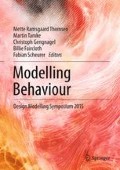Abstract
This paper discusses the challenges that designers face when modelling the anticipated behaviours of people: their movement and transactions around and within precinct scale development. Building Information Modelling (BIM) software philosophy contrasts with that of City Information Modelling (CIM)—the route by which we consider how precinct scale development, being somewhere between the two (BIM and CIM), requires a wholly different approach to information and behaviour modelling. The authors offer evidence of the value of augmenting the planners’ analytical approach with the architects’ synthesis from data leading to meaningful speculations on otherwise unanticipated future scenarios for the precinct far beyond expectation. Novel approaches to modelling behaviour at precinct scale suggest alternative readings of precincts, which require a wider set of approaches to Precinct Information Modelling (PIM) software development than simply an expansion of BIM.
Access this chapter
Tax calculation will be finalised at checkout
Purchases are for personal use only
References
Aram S, Eastman C (2013) Integration of PLM solutions and BIM systems for the AEC industry. In: Proceedings of the 30th ISARC, Montréal, Canada, pp 1046–1055
Aschwanden G, Zhong C, Papadopoulou M, Vernay DG, Arisona SM, Schmitt G (2012) System design proposal for an urban information platform: a systems proposal
Batty M, Torrens P (2005) Modelling and prediction in a complex world. Futures (37) pp 745–766. Available online at www.sciencedirect.com
Brenner N (2014) Implosions/explosions: towards a study of planetary urbanization. JOVIS, Berlin
Bruelisauer M, Berthold S, Aschwanden G, Belle I, Ostertag E, Meggers F (2013a) Reclaiming Backlanes–addressing energy efficiency, outdoor comfort and urban space. In: Proceedings of the Sb13 Singap
Bruelisauer M, Meggers F, Engler R, Leibundgut H (2013b) Heat bus for the tropics–exergy analysis of coupling decentralised chillers with central cooling towers. In: Proceedings of the clima 2013 energy efficiency smart healthy buildings
Burkhard R, Schmitt G (2009) Visualising future cities in the Eth value lab. In: Mixed reality in architecture, design and construction. Springer, Netherland, pp 205–218
Burry M (2014) BIM and MetaBIM: design narrative and modeling building information, pp 349–361. In: Kensek KM, Noble DE (2014) Building information modeling: BIM in current and future practice, Wiley, NYC USA
Capra F (1996) The web of life: new scientific understanding of living systems. Anchor Books, Michigan
Geli-Mann M (1994) Complex adaptive systems. Complex metaphors models Reality, 17–45
Goffin P, Ritter V, John V, Baetschmann M, Leibundgut H (2011) Analyzing the potential of low exergy building refurbishment by simulation. In: Proceedings of building simulation
Holland J (1995) Hidden order: how adaptation builds complexity. Addison—Wesley, Reading
Holzer D (2011) BIM’s seven deadly sins. Int J Archit Comput 9(4):463
Jongeling R, Olofsson T (2007) A method for planning of work-flow by combined use of location-based scheduling and 4D CAD. Autom Construct 16:189–198
Kenley R, Seppänen O (2009) Location-based management of construction projects: part of a new typology for project scheduling methodologies. In: Winter simulation conference. Winter simulation conference, Austin
Kensek KM, Noble DE (2014) Building information modeling: BIM in current and future practice. Wiley, NYC USA
Kvan T, Thilakaratne R (2003) Models in the design conversation: architecture vs engineering. In: Newton C, Kaji-O’Grady S, Wollan S (eds) Design + research: project based research in architecture, The Association of Architecture Schools of Australasia, Australia
Ming LJ, Suan TP, Toh W (2010) Hdb’s next generation of eco-districts at Punggol and eco-modernisation of existing towns. Ies J Part A Civil Struct Eng 3:203–209
Ordóñez Medina SA, Erath A (2013) Estimating dynamic workplace capacities by means of public transport smart card data and household travel survey. In: Transportation research record, pp 20–30
Saurin TA, Rooke J, Koskela L (2013) A complex systems theory perspective of lean production. Int J Prod Res 51:5824–5838
Simeone D, Kalay YE (2012) An event-based model to simulate human behaviour in built environments. In: Digital physicality—proceedings of the 30th eCAADe conference, Czech Technical University in Prague, Faculty of Architecture (Czech Republic) 12–14 September 2012, pp 525–532
Torrens P (2005) Knowledge and complexity. Futures (37):581–584 (Science direct). Available online at www.sciencedirect.com
White M (2010) The subtracto—sun: 4D solar envelope. In: Burry M, Ostwald M, Downton P, Mina A (eds) Homo faber: modelling identity and the post digital, Archadia Press, Sydney, pp 111–124
White M (2014) Preserving open space amenity using subtractive volumetric modelling, global demographic and climate challenges in the city, Aachener Geographische Arbeiten, Heft 50. Department of Geography of RWTH Aachen University, Germany, pp 107–126
White M, Langenheim N (2014) Urban street tree modelling using high polygon 3D models with photometric daylight systems. In: Oliveira V, Pinho P, Batista L, Patatas T, Monteiro C (eds) Our common future in urban morphology. Porto, Portugal, FEUP, pp 256–267
Zhang X, Arayici Y, Wu S, Abbott C, Aouad G (2009) Integrating BIM and GIS for large-scale facilities asset management: a critical review. In: The twelfth international conference on civil, structural and environmental engineering computing, pp 1–4 (2009) at Funchal. Madeira, Portugal
Author information
Authors and Affiliations
Corresponding author
Editor information
Editors and Affiliations
Rights and permissions
Copyright information
© 2015 Springer International Publishing Switzerland
About this chapter
Cite this chapter
Burry, M., Karakiewicz, J.A., Holzer, D., White, M., Aschwanden, G.D., Kvan, T. (2015). BIM-PIM-CIM: The Challenges of Modelling Urban Design Behaviours Between Building and City Scales. In: Thomsen, M., Tamke, M., Gengnagel, C., Faircloth, B., Scheurer, F. (eds) Modelling Behaviour. Springer, Cham. https://doi.org/10.1007/978-3-319-24208-8_34
Download citation
DOI: https://doi.org/10.1007/978-3-319-24208-8_34
Published:
Publisher Name: Springer, Cham
Print ISBN: 978-3-319-24206-4
Online ISBN: 978-3-319-24208-8
eBook Packages: EngineeringEngineering (R0)

